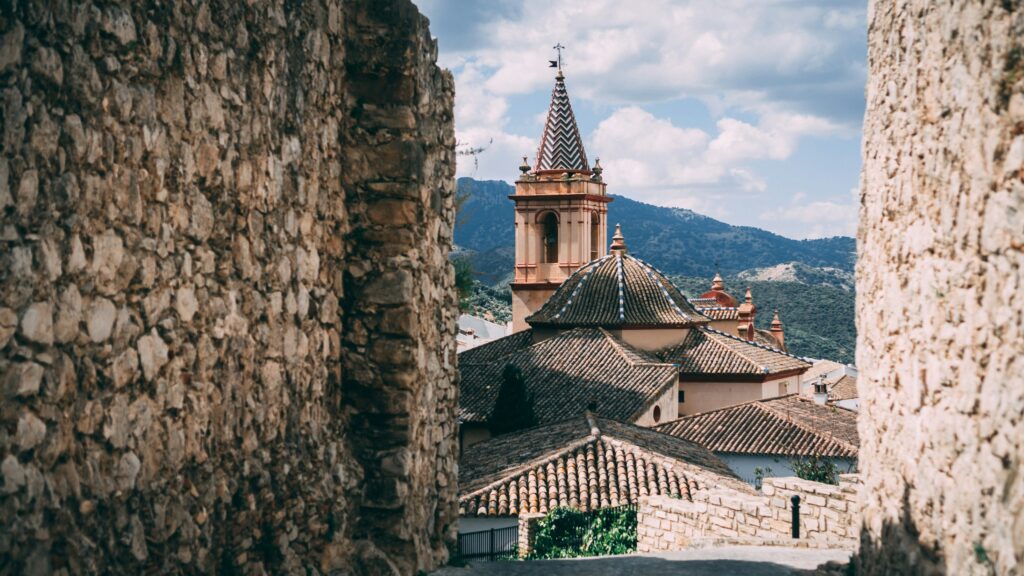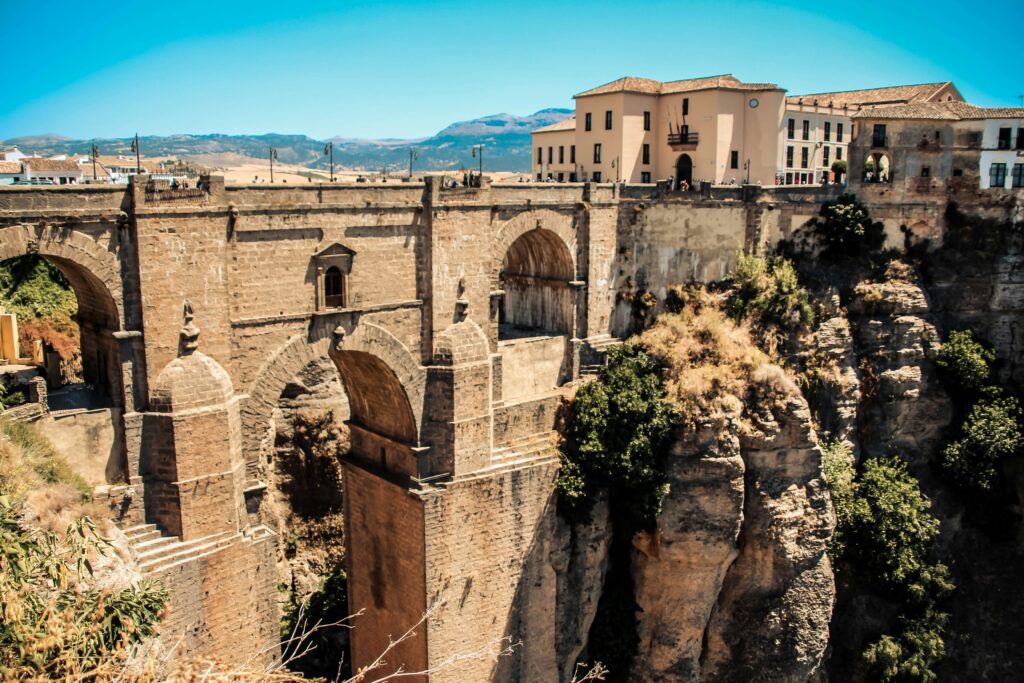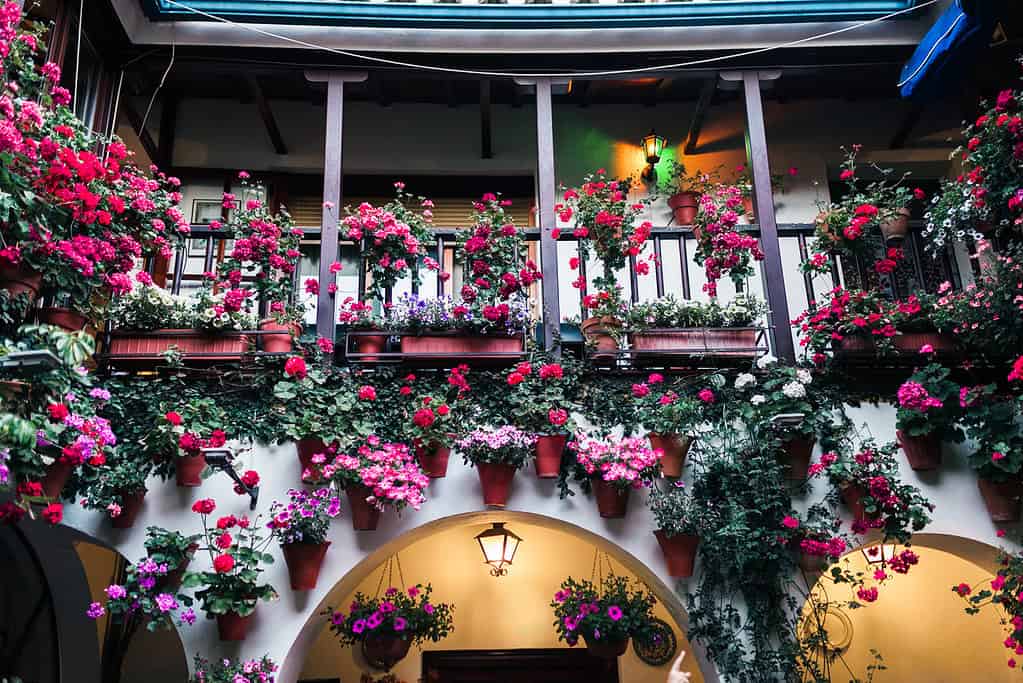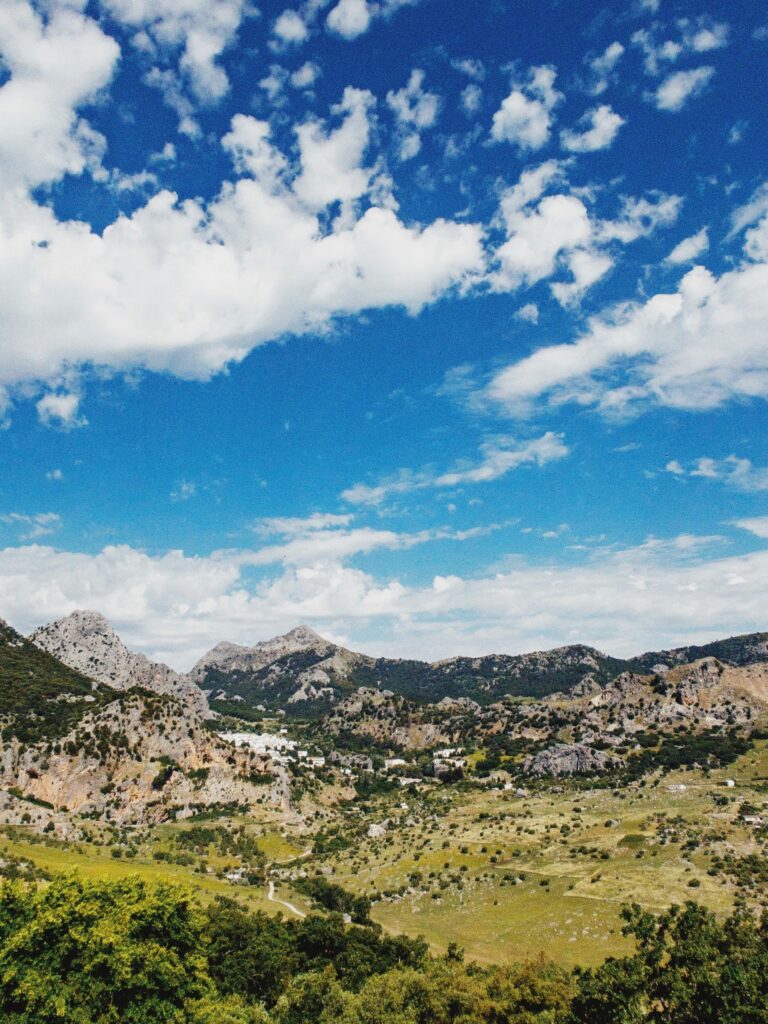This isn’t about getting from point A to point B. This is Malaga to Seville, which is another way of saying sun-drenched roads, olive trees that never end, Moorish towns that shimmer in the heat, and roadside stops that ruin your concept of time management.
The route? Flexible. The vibe? Golden hour. The soundtrack? Somewhere between Paco de Lucía and your own playlist that somehow hits better when you’re rolling past a field of sunflowers with the windows down.
This is a trip best done slowly—Andalusia doesn’t reward rushing. What it does reward: curiosity, good shoes, an appetite, and a willingness to turn off the main road when a castle shows up unannounced on a hill.
Let’s map it out: where to stop, what to eat, what not to skip, and how to do the Malaga to Seville road trip like someone who knows better.

*Note some of the links feature affiliate links. I only recommend items that I 100% love and think you will too!
Why Drive From Malaga to Seville?
You could take the train. You could even take a bus. But then you’d miss:
- The tiny towns with no tourism strategy and the best olives you’ve ever tasted
- That one overlook where you pull over just because the light looks different
- The moment you realize Andalusia isn’t a region—it’s a mood
Driving from Malaga to Seville gives you the in-between. The texture. The stuff you can’t photograph well but somehow talk about for years afterward.
Distance & Time
- Malaga to Seville (direct): ~205 km (~2 hours 15 mins on the A-92)
- With stops: 4–8 hours, depending on your capacity for spontaneous turns and leisurely lunches
When to Go: Timing Your Malaga to Seville Road Trip Just Right
Andalusia isn’t shy with the sun. Summer can be… let’s call it “volcanic,” especially inland. If you want to enjoy this drive without melting into your rental car upholstery, aim for:
- Spring (March–May): Orange blossoms, mild temps, fewer crowds
- Fall (September–October): Still warm, but breathable. Everything glows.
- Winter (December–February): Crisp mornings, fewer tourists, and off-season hotel rates. Just check local festival dates.
Avoid late July to August unless you enjoy existential sweating and traffic on roads that haven’t seen rain in six months.
Route Overview: From Coastline to Capital
Here’s the basic idea:
Malaga → Antequera → El Torcal → Osuna → Carmona → Seville
You can swap in Ronda if you want a loopier, more mountainous drive. Or add Córdoba if you’ve got extra time. But for the pure Malaga to Seville experience? This route gives you the architectural spice, the olive oil, the medieval towers, and the breeze that smells like jasmine and possibility.
Stop 1: Malaga – The Gateway to the South
Start where the coast meets the culture. Malaga has shrugged off its fly-in-fly-out reputation and grown into itself—arty, confident, and layered like every good Andalusian city.
Do this before you leave:
- Grab breakfast at Casa Aranda (churros and thick chocolate, obviously)
- Walk the Alcazaba, a warm-up for the Moorish architecture to come
- Pop into the Picasso Museum—Malaga is his hometown, after all
- Pick up snacks at Atarazanas Market—fresh fruit, olives, jamón, always jamón
Gas up. Get your bearings. Cue your road trip playlist. You’re heading inland.
Stop 2: Antequera – Whitewashed Walls and Old Stones
An hour from Malaga, Antequera is your first real immersion into the heartland of Andalusia. It’s overlooked, which makes it even better.
What not to miss:
- The Dolmens of Antequera—Neolithic tombs older than your existential crisis
- The view from the Alcazaba fortress
- Wandering the narrow streets and finding a bakery that doesn’t even have a name
If you’ve got time (and legs that don’t mind a climb), detour to El Torcal Natural Park. It’s like Mars and southern Spain had a child made of limestone. Hike, get lost, re-find yourself.
Stop 3: Osuna – Game of Thrones, But Make It Spanish
Osuna is about 90 minutes from Antequera, and it’s not just a pretty face. Though yes, the architecture is stunning—a caramel-colored baroque town center that catches golden hour like it was designed for it.
Why Osuna’s worth the stop:
- The University of Osuna is surprisingly photogenic
- The Collegiate Church is grand without the crowds
- You might recognize some spots if you’re a Game of Thrones nerd (they filmed scenes here)
Lunch here if you can. This is where you slow down, pick a shady terraza, and give up any concept of a strict schedule.
Stop 4: Carmona – A Gateway to Seville with Serious Presence
Carmona doesn’t show off—but it could. A hilltop city with Moorish gates, Roman ruins, and a Parador in a castle, it’s the kind of place that whispers, “Yes, you should have stayed the night.”
Best things to do in Carmona:
- Stroll through the Puerta de Sevilla and onto the old Roman road
- Visit the necropolis if you’re into tombs and time travel
- Grab a drink on the Parador terrace for one of the best views in Andalusia
It’s close enough to Seville to be a final stop, but far enough to feel like its own reward.
Final Destination: Seville – The Capital of Style and Sound
And then—you arrive. You roll into Seville a little dustier, a little hungrier, and a lot more tuned in. This city moves differently. Faster in energy, slower in pace. Louder. But in a way that invites you in instead of pushing you out.
Once you’re here:
- Catch flamenco that doesn’t feel like a theme park—try Casa de la Memoría Flamenco Show
- Visit the Royal Alcázar (yes, buy your ticket ahead)
- Eat salmorejo, spinach with chickpeas, grilled pork cheek, and whatever’s scribbled on the chalkboard that day
- Wander Triana at night. It’s not a recommendation. It’s an assignment.
Want to Go Slower? Make It a Two- or Three-Day Trip
One of the best things about the Malaga to Seville route is how customizable it is. If you’ve got time to spare, consider breaking the drive into overnight stays.
Suggested slow itinerary:
- Night 1: Antequera or La Posada del Torcal lodge – Quiet, high up, stars like you forgot were possible
- Night 2: Osuna or Carmona – Sleep in a town where you’ll hear church bells and not much else
- Final: Seville – You’ll roll in feeling like you earned every second of it
This isn’t a checklist road trip. It’s about noticing things. Smelling jasmine on a breeze. Watching light hit limestone. Having time to stop when something looks vaguely castle-ish in the distance.
Alternative Routes: If You Want to Detour (And You Do)
Let’s say you’re a scenic route kind of person. Good news: there are options.
- Via Ronda – Head west out of Malaga through the mountains, visit Ronda (famous bridge, dramatic gorge), then loop north to Seville
- Add Córdoba – It’s a detour north, but worth it for the Mezquita alone. Great lunch stop if you want history with your espresso.
- Via the Sierra de Grazalema – White villages, winding roads, a slower, quieter Andalusia
If you take any of these? Double your drive time and thank yourself later.

Alternate Route 1: Via Ronda – The Dramatic Detour
This route takes you west from Malaga and into the Serranía de Ronda—a landscape that doesn’t believe in straight lines or average views. If you want jaw-dropping scenery with a touch of historic gravity, this is your move.
Why take this route?
It’s arguably the most scenic drive in Andalusia, with switchbacks that climb through pine-covered mountains, and a final arrival into Ronda that feels cinematic. You’ll swap the highway for drama, and you’ll love yourself for it.
Route snapshot:
- Malaga → Ardales → Ronda → Zahara de la Sierra (optional) → Seville
- ~4.5 to 6 hours with stops (you’ll want them)
What to see and do:
- Ronda:
- The Puente Nuevo bridge over the El Tajo gorge is the headline act. Yes, it’s popular. Yes, it’s worth it.
- Walk the old town, where the air smells faintly of orange peel and stone.
- Visit the bullring (even if you’re not a fan of the sport—the architecture is something else).
- Grab lunch with a view. Lots of places serve jamón; not all serve it on a cliffside.
- The Puente Nuevo bridge over the El Tajo gorge is the headline act. Yes, it’s popular. Yes, it’s worth it.
- Optional stop – Zahara de la Sierra:
- A white village perched above a reservoir, framed by mountains. Feels like a dream someone painted.
- A solid coffee stop or overnight if you want to slow down.
- A white village perched above a reservoir, framed by mountains. Feels like a dream someone painted.
- Drive to Seville:
- Once you leave the mountains, the road straightens and the landscape stretches—olive trees, warm air, and the scent of dry grass.
- Once you leave the mountains, the road straightens and the landscape stretches—olive trees, warm air, and the scent of dry grass.
This route is perfect for romantics, photographers, and people who like a little grandeur in their geography.

Alternate Route 2: Add Córdoba – History With Your Espresso
This isn’t a detour—it’s a pilgrimage. Córdoba is one of Andalusia’s crown jewels, and skipping it just because it’s a bit out of the way feels like throwing out the best chapter of the book.
Why take this route?
Because Córdoba’s Mezquita alone is worth rerouting your day, and the old Jewish Quarter is the kind of place you wander for an hour without realizing you’ve taken a hundred photos of shadows on stone.
Route snapshot:
- Malaga → Lucena → Córdoba → Écija (optional) → Seville
- ~5 to 6.5 hours total, depending on lunch and museum stamina
What to see and do:
- Córdoba:
- Visit the Mezquita-Catedral—a former mosque turned cathedral, layered with history and surprisingly spiritual, even if you’re not.
- Stroll through the Judería—narrow streets, white walls, hanging flower pots, and the kind of quiet you remember.
- Eat lunch at Bodegas Campos or a tucked-away taberna that smells like garlic and possibility.
- Stop by the Roman Bridge, especially if the light is low.
- Visit the Mezquita-Catedral—a former mosque turned cathedral, layered with history and surprisingly spiritual, even if you’re not.
- Optional stop – Écija:
- Known as “the frying pan of Andalusia” (yes, it gets hot), this lesser-known town has baroque towers and not many tourists.
- Good for a quick coffee or a slice of local life that hasn’t been polished for postcards.
- Known as “the frying pan of Andalusia” (yes, it gets hot), this lesser-known town has baroque towers and not many tourists.
This is your route if you like your road trips with a side of 1,000 years of history and a perfectly timed afternoon vermut.

Alternate Route 3: Via the Sierra de Grazalema – White Villages and Quiet Roads
This is the poet’s route. The one you take when you’re in no rush. When you’re more interested in stillness than spectacle. This drive threads through the Sierra de Grazalema Natural Park, home to some of Spain’s most postcard-perfect white villages—and also some of its most peaceful corners.
Why take this route?
Because this is where Andalusia exhales. The landscapes are softer, the villages quieter, and the road itself becomes the experience. Ideal for a detour that feels like a meditation with scenery.
Route snapshot:
- Malaga → El Burgo → Grazalema → Zahara de la Sierra → Seville
- 6+ hours with stops, longer if you stay overnight (and you’ll probably want to)
What to see and do:
- El Burgo
- Small, local, real. A quick breakfast stop or slow detour.
- Fields of cork oaks and almond trees mark the way in.
- Small, local, real. A quick breakfast stop or slow detour.
- Grazalema
- A mountain village wrapped in mist in the mornings.
- Known for wool, walking trails, and stillness.
- A perfect place for a quiet meal, a short hike, or just a pause from motion.
- A mountain village wrapped in mist in the mornings.
- Zahara de la Sierra
- (Yes, again—because it fits here too)
- Worth stopping for the castle views and reservoir below.
- Grab local cheese or honey—this region takes its produce seriously.
- (Yes, again—because it fits here too)
Driving through Grazalema means winding roads, slow curves, birds overhead, and that rarest of road trip feelings: not needing to talk.
Looking for Places to Stay? Use the Map Below to Scout Hotels Along the Route
Sure, you could wing it and book whatever pops up when your eyelids start to droop somewhere outside Antequera. Or—you could take five minutes now and find the kind of stay you’ll actually want to remember.
Use the map below to browse hotels, boutique stays, countryside retreats, and offbeat options across the Malaga to Seville drive. Zoom in on spots like Ronda, Osuna, or Grazalema, and you’ll spot gems that aren’t even on the usual booking sites’ radar.
Think:
- Hilltop inns with Moorish arches
- Guesthouses run by people who still bake you a welcome cake
- Design-forward boutiques hiding in sleepy villages
- Paradores in castles, because Spain’s cool like that
📍 Scroll, click, compare—and pin the places that make you want to pull over and stay awhile. You’re not just booking a bed. You’re bookmarking a moment.
What to Eat Along the Way
This road trip isn’t just photogenic—it’s absurdly well-fed. Andalusia doesn’t do bland. Every stop along the Malaga to Seville journey serves up something worth remembering, even if you forget where you parked.
Malaga
- Espeto de sardinas: Grilled over open flames on the beach, smoky and perfect with a beer.
- Ajoblanco: A cold almond-garlic soup that’s somehow both refreshing and rich.
- Boquerones: Anchovies done right. Don’t fight it—just try them.
Antequera
- Mollete: Soft, pillowy bread rolls stuffed with whatever the cook felt inspired by. Often ham. Always a good idea.
- Porra Antequerana: A local version of salmorejo—thicker, smoother, and basically a meal.
Ronda (if you take the scenic route)
- Rabo de toro (oxtail stew): Slow-cooked and deeply Andalusian.
- Payoyo cheese: Sharp, creamy goat cheese from the surrounding Sierra.
- Honey + almond sweets: You’ll find these in old bakeries—bite-sized, not overly sweet, and sneakily addictive.
Zahara de la Sierra / Grazalema (if you go through the Sierra de Grazalema)
- Local venison or lamb: Often stewed with wild herbs from the hills.
- Grazalema cheeses: Sheep and goat milk blends, sold from tiny shops that smell amazing.
- Wild mushroom tapas: Seasonal and foraged—especially in autumn.
Osuna
- Salmorejo: Creamy, cold, tomato perfection. Richer than gazpacho and often topped with jamón and egg.
- Flamenquín: Breaded, fried pork rolled with ham and cheese. Like a cordon bleu but way better.
Córdoba (if you detour that way)
- Berenjenas con miel: Fried eggplant drizzled with local honey or molasses. Trust us.
- Mezquita-style tapas: Influenced by centuries of Moorish rule—think cumin, citrus, mint.
- Rabo de toro, again—because Córdoba claims it, and the version here is often slow-cooked to silk.
Carmona
- Locally pressed olive oil: Try it plain with bread. Yes, really.
- Jamón ibérico: The real stuff, from free-range acorn-fed pigs.
- Toasted almonds: Sold in paper cones, salty and warm, often by street vendors.
Seville
- Espinacas con garbanzos: Spinach and chickpeas, spiced and stewed to comfort perfection.
- Carrillada: Braised pork cheek that melts like memory foam.
- Tortilla de camarones: Crispy shrimp fritters—best in hole-in-the-wall spots.
- Tapas crawl in Triana or Alameda: Avoid the cathedral cluster. Follow locals. Order the weird-sounding thing. Win.
Pro tip: Don’t plan your meals too tightly. Some of the best dishes happen when you sit down with zero expectations and say, “What do you recommend?” Let the food be part of the discovery.
Practical Tips for the Drive from Malaga to Seville
Some road trip logistics—because being unprepared might be charming in a rom-com, but not when you’re low on gas in the Andalusian countryside.
- Rent the right car: Small is smart in towns. Go manual if you’re comfy.
- Gas stations: Plan ahead. Fill up before leaving big towns like Antequera.
- Toll roads: Not many, but check your GPS settings. The scenic routes don’t cost extra.
- Parking in Seville: Tight and competitive. Park on the edge of the center and walk in—or book a hotel with a garage.
- Download maps: Cell signal can ghost you in the hills. Offline maps save stress.
- Driving rules: Flashing lights = move over. Locals drive fast, but not recklessly.
Slow Down: Special Experiences That Make Andalusia Feel Different
Driving through Andalusia isn’t just about getting from Malaga to Seville—it’s about the texture between the landmarks. The moments when you stop chasing the itinerary and start absorbing where you actually are.
One of the most distinct Andalusian experiences? The Arab baths—Baños Árabes. They’re not tourist traps. They’re time machines. You walk in and the city noise fades. What you get instead: dim light, warm water, cool marble, and a kind of silence that feels old. Old in a good way.
Where to go for the best Baños Árabes experiences:
Malaga – Hammam Al Ándalus
Right near the old town, this restored bathhouse uses scents, tiles, and textures to recreate the Moorish bathing tradition. Think steamy pools, mint tea in silence, and a massage that resets your whole nervous system. Book a bath and massage here
Ronda – Baños Árabes (historic ruins)
Not operational, but still worth seeing. These are among the best-preserved medieval Arab baths in Spain. Walk through the cool stone arches and imagine what this place sounded like when it was full of water, voices, and light. Check out the historic ruins here
Córdoba – Hammam Al Ándalus Córdoba
Possibly the most atmospheric of the modern bathhouses. Located just steps from the Mezquita, it’s the perfect follow-up to a day of wandering. Book the longer massage. You won’t regret it. Book your bath and massage here
Granada (if you ever detour that far)
The hammam here is built into a historic space and somehow feels even older than it is. Deeply relaxing, almost meditative, with domed ceilings that make you feel like you’re floating under a star map. Book your bath and massage here
Why it’s worth making time for the baths:
- It connects you to Andalusia’s Moorish past, not through facts, but through feeling.
- It forces you to slow down and just be. In a culture that excels at taking its time, you get to practice doing the same.
- It’s not just relaxing—it’s grounding. A sensory reset after a long travel day.
- And yes, you’ll sleep better that night. Guaranteed.
FAQs: Malaga to Seville Travel—What You Really Need to Know
What’s the best way to get from Málaga to Seville?
It depends on your mood (and how much time you’ve got). The fastest way is the AVE high-speed train—about 2 hours, no stress. The most scenic and flexible way? Hands down, a road trip. That lets you detour through places like Ronda, Osuna, or even Córdoba. There’s also the bus, but it’s the least interesting option unless you’re just looking to get there and nap.
Is going to Seville worth it?
Yes. Without hesitation. Seville is one of Spain’s most vivid cities—architecture, flamenco, food, and a vibe you don’t fake. It’s hotter than other cities (literally), but it’s also warmer in spirit. If you skip it, you’re skipping a chapter of Spain that explains a lot.
How much is a train ticket from Málaga to Seville?
Ticket prices vary depending on when you book and which class you choose. On average:
- Standard fare: €25–€40
- Promo deals (booked early): as low as €15
- First class or flexible fare: €50–€60+
Pro tip: Check both Renfe and Trainline—sometimes one has better deals or clearer booking options.
What is the best way to get from Seville to Málaga?
Same options, just in reverse.
- Train if you want speed and simplicity.
- Car if you’re coming back a different way—or want to stop in Córdoba, Antequera, or even make a day out of Ronda.
- Bus works, but it’s more of a backup plan. Budget-friendly, less charm.
If you’ve already seen the coast, take the inland route on the way back. Andalusia’s interior is full of surprises, and the road from Seville back to Málaga isn’t just about distance—it’s about wrapping the trip in a few more stories.
Conclusion: Malaga to Seville Is More Than a Drive—It’s the Good Stuff in Between
Anyone can get from Malaga to Seville. But how you get there? That’s the difference between a transfer and a story.
This drive isn’t about efficiency. It’s about the olive groves that go on forever, towns with three cafés and two saints, the hills that turn orange in late afternoon, and the way each stop adds something to the bigger picture.
It’s the best of Andalusia on one stretch of road: Malaga’s edge, Antequera’s stone bones, Osuna’s quiet confidence, Carmona’s layers—and finally, Seville’s full-volume joy.
So no, it’s not just a road trip. It’s a mood. A map of feeling. A stretch of road that invites you to do less, notice more, and fall a little harder for this sun-washed corner of Spain.
Further Reading
- Flamenco Magic: Exploring the Best Flamenco Shows in Andalucia
- Pack Like a Pro: The Ultimate Europe Packing List
- How to Plan the Perfect Trip to Europe: Tips and Tools
- Malaga Where to Stay: The Best Neighborhoods and Hotels
- Coastal Magic: The 9 Best Beaches Malaga Has to Offer
- Malaga: How Many Days Do You Really Need? The Insider’s Guide
- Malaga with a Baby
- Andalucia Experience Guide by Lonely Planet
- Andalucia Classic Guide by Lonely Planet
Disclaimer: The content on Must See Spain is provided “as is” with no guarantees of accuracy, reliability, or suitability. Travel involves risks, including injury, illness, theft, or unexpected events. Must See Spain is not responsible for any issues encountered during your travels. Always verify information independently and check local sources before making plans.
Comments Off on The Ultimate Andalusian Road Trip: Malaga to Seville